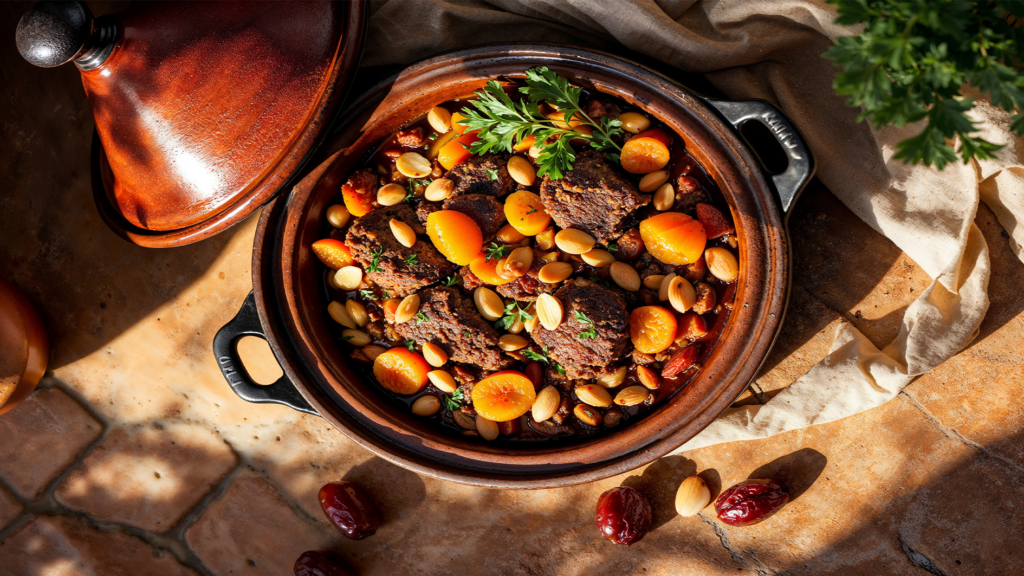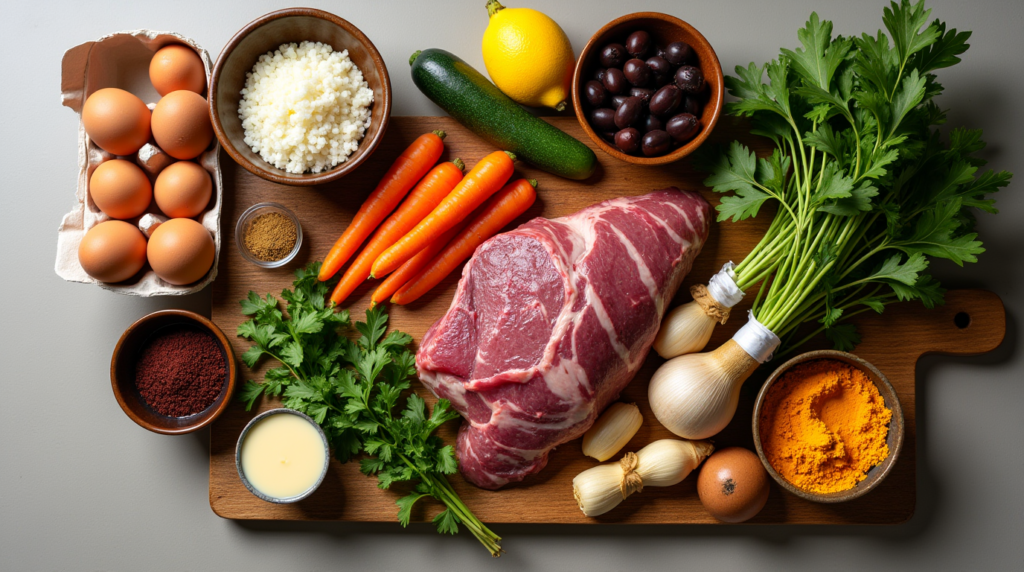Few dishes capture the essence of Moroccan cuisine as beautifully as tagine—a slow-cooked, aromatic stew bursting with tender meat, sweet and savory spices, and caramelized vegetables. Named after the iconic earthenware pot it’s cooked in, Moroccan tagine is a celebration of flavor, tradition, and communal dining.
Whether you’re savoring succulent lamb with prunes, chicken with preserved lemons, or a hearty vegetable medley, each bite tells a story of Morocco’s rich culinary heritage. In this guide, we’ll explore the secrets behind an authentic tagine, from its ancient Berber roots to the perfect blend of spices that make it unforgettable.

Table of Contents
🔑 Key Takeaways
- Origin: A traditional Berber dish from North Africa, cooked in a conical clay pot for slow, even heat.
- Signature Flavors: Sweet and savory, with spices like cumin, cinnamon, ginger, and saffron.
- Cooking Method: Slow-simmered over low heat, allowing flavors to meld beautifully.
- Serving Style: Traditionally eaten with Moroccan bread or couscous, shared family-style.
- Versatility: Can be made with lamb, chicken, beef, fish, or vegetables.
- Key Ingredients: Preserved lemons, olives, dried fruits, and aromatic spices define its taste.
- Cultural Significance: A centerpiece of Moroccan hospitality and festive gatherings.
🌍 Cultural Heritage: The Story Behind Moroccan Tagine
Moroccan tagine traces its roots to the indigenous Berber people, who developed this slow-cooking method to make the most of scarce water and tough cuts of meat in the arid North African climate. The distinctive conical lid of the tagine pot allows steam to circulate, condense, and drip back into the dish, keeping it moist and flavorful.
Historically, tagine was a meal for special occasions—weddings, religious holidays, and family gatherings. Today, it remains a symbol of Moroccan hospitality, often served to guests as a gesture of warmth and generosity. Each region has its own variation, from the sweet and fruity tagines of Fez to the spicy, olive-heavy versions of Marrakech.

🥘 Essential Ingredients for an Authentic Moroccan Tagine
The magic of tagine lies in its balance of sweet, savory, and tangy flavors. Here’s what you’ll need:
Protein
- Lamb (shoulder or shank)
Aromatics & Vegetables
- Onions (slow-cooked for sweetness)
- Garlic (for depth)
- Carrots, potatoes, zucchini (for texture)
- Preserved lemons (a must for tanginess)
- Green olives (for a briny contrast)
- Dried apricots, prunes, or raisins (for sweetness)
Signature Spices
- Cumin (earthy warmth)
- Ginger (subtle heat)
- Cinnamon (sweet fragrance)
- Turmeric (golden color)
- Paprika or saffron (for depth)
- Fresh cilantro & parsley (herbal freshness)
🧂 Preparation & Marination Techniques
1. Marinate for Depth of Flavor
- Coat meat in spices, olive oil, and garlic (at least 2 hours, ideally overnight).
- For extra tenderness, add a splash of lemon juice or yogurt to the marinade.
2. Layering is Key
- Start with onions at the bottom to prevent sticking and add sweetness.
- Place meat in the center, surrounded by vegetables and dried fruits.
- Drizzle with broth or water (just enough to steam, not drown).
🌶️ Secret to Authentic Seasoning: Ras el Hanout
The soul of Moroccan tagine lies in its spice blend. While every household has its own mix, Ras el Hanout (“top of the shop”) is the gold standard. A typical blend includes:
- Cinnamon
- Cumin
- Coriander
- Cardamom
- Nutmeg
- Cloves
- Allspice
Pro Tip: Toasting whole spices before grinding enhances their aroma!
👩🍳 Step-by-Step Cooking Method
1. Sear the Meat
- Brown meat in olive oil for a rich base flavor.
2. Sauté Aromatics
- Cook onions until golden, then add garlic and spices.
3. Slow Simmer
- Return meat to the pot, add vegetables, dried fruits, and broth.
- Cover and cook on low heat (stovetop or oven at 300°F/150°C) for 2-3 hours.
4. Finish with Freshness
- Stir in preserved lemons, olives, and fresh herbs in the last 20 minutes.
⚠️ Common Mistakes to Avoid
- Overcrowding the pot → Prevents even cooking.
- Too much liquid → Tagine should be thick, not soupy.
- Skipping marination → Results in less flavorful meat.
- High heat → Can toughen meat; low and slow is best.
🍞 Traditional Side Dishes & Accompaniments
- Khobz (Moroccan bread) – For soaking up juices.
- Couscous – Light and fluffy, perfect with tagine.
- Fresh salads – Orange & olive, or cucumber-tomato.
- Mint tea – The classic Moroccan drink to balance richness.
♨️ Storage & Reheating Guidelines
- Fridge: Keeps for 3-4 days in an airtight container.
- Freezer: Store for up to 3 months (without potatoes).
- Reheating: Warm gently on the stovetop with a splash of water.
🌟 Conclusion: Bring Morocco to Your Table
Moroccan tagine is more than a dish—it’s an experience, a story, and a labor of love. Whether you’re cooking for family or hosting a dinner party, this fragrant stew will transport your taste buds straight to the bustling souks of Marrakech.
📢 Your Turn! Have you tried making tagine before? Share your favorite variations in the comments below!**
❓ FAQ: Moroccan Tagine
1. Can I make tagine without a tagine pot?
Yes! Use a Dutch oven or heavy-bottomed pot with a tight lid.
2. What’s the best meat for tagine?
Lamb and chicken are most traditional, but beef and fish work too.
3. Can I make vegetarian tagine?
Absolutely! Use chickpeas, squash, eggplant, and carrots.
4. Why are preserved lemons important?
They add a unique tangy depth that fresh lemons can’t replicate.
5. How do I prevent my tagine from burning?
Low heat, enough liquid, and occasional stirring help.
Ready to cook? Tag us with your #MoroccanTagine creations! 🇲🇦✨
